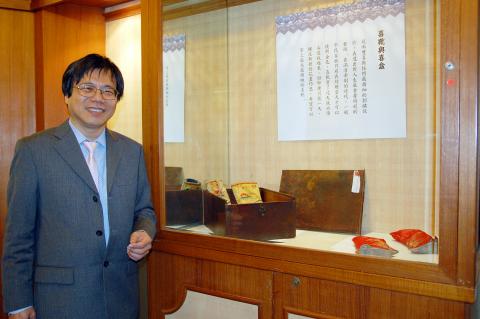A physician, who has been interested in the Chinese practice of foot binding since an early age, has put his collection of thousands of artifacts on display.
The result of David Ko’s (柯基生) endeavor over the past three decades is being exhibited through Jan. 26 at the Sansia History Museum in Sansia District (三峽), New Taipei City (新北市).
Ko said the foot-binding custom has more than 1,000 years of history in China, while it was only in the relatively modern era that Taiwan took up the practice.

Photo: Wang Kai-lin, Taipei Times
“Foot-binding was introduced to Taiwan by the occupying army of the Ming Dynasty warlord Koxinga [Cheng Chen-kung, 鄭成功] in the 17th century, but it only really spread to the common folk in the 19th century,” he said.
“In the beginning, the settlers from China were mostly poor and faced difficult living conditions in Taiwan. It was only later on when some people became prosperous, that female foot-binding became more common, especially among urban residents,” said. “At its peak, one estimate indicated that up to 70 percent of women in Taiwan had their feet bound.”
Women’s rights activists have said the custom amounts to enslaving females — giving them a life of pain and restricted movement. They have said it was the Chinese patriarchal society’s way of suppressing women — deforming their feet to satisfy a male notion of erotic desire. As such, activists have said it should not be romanticized nor promoted as some kind of fashion concept or an appealing cultural legacy.
Ko said his research showed that the Hakka, mountain Aboriginal groups and lowland Pingpu Aboriginals did not practise footbinding, but due to increased interaction with Han Chinese over the centuries, some of the groups took up the practice.
The practice resulted in what was known by the Chinese as the “three-inch golden lotus” (三寸金蓮). The Chinese inch (寸) is a little longer than 3cm so the preferred foot length was less than 10cm.
Ko said the woven and embroidered shoes used to bind feet were not as refined in Taiwan as those made in China because of the custom’s short history in the nation.
“However, there are localized differences and we do have specialty styles that are distinct from Chinese styles,” he added.
Most of the tiny shoes used to bind feet in Taiwan were various shades of red to express family bliss and vitality, Ko said.
The early migrants from the Zhangzhou and Chuanzhou regions of Fujian Province incorporated the wooden high-heel slippers from their cultures, which enclosed the bound feet and gave them a slender look, Ko said.
Ko, who has a collection of more than 6,000 pairs of the shoes, said he began to study foot-binding customs when he was about 10 and said that “it led to an interest in physiology and formed his thinking to become a medical doctor.”
Sansia District Administrator Yang Chih-hung (楊志宏) said his great-grandmother had bound feet.
“Through systematic collection, compilation and planning, the public will have a deeper understanding about this old custom,” Yang said of the exhibit.

ANOTHER EMERGES: The CWA yesterday said this year’s fourth storm of the typhoon season had formed in the South China Sea, but was not expected to affect Taiwan Tropical Storm Gaemi has intensified slightly as it heads toward Taiwan, where it is expected to affect the country in the coming days, the Central Weather Administration (CWA) said yesterday. As of 8am yesterday, the 120km-radius storm was 800km southeast of Oluanpi (鵝鑾鼻), Taiwan’s southernmost tip, moving at 9kph northwest, the agency said. A sea warning for Gaemi could be issued tonight at the earliest, it said, adding that the storm is projected to be closest to Taiwan on Wednesday or Thursday. Gaemi’s potential effect on Taiwan remains unclear, as that would depend on its direction, radius and intensity, forecasters said. Former Weather Forecast

As COVID-19 cases in Japan have been increasing for 10 consecutive weeks, people should get vaccinated before visiting the nation, the Centers for Disease Control (CDC) said. The centers reported 773 hospitalizations and 124 deaths related to COVID-19 in Taiwan last week. CDC Epidemic Intelligence Center Director Guo Hung-wei (郭宏偉) on Tuesday said the number of weekly COVID-19 cases reported in Japan has been increasing since mid-May and surpassed 55,000 cases from July 8 to July 14. The average number of COVID-19 patients at Japan’s healthcare facilities that week was also 1.39 times that of the week before and KP.3 is the dominant

The Chinese Communist Party’s (CCP) working group for Taiwan-related policies is likely to be upgraded to a committee-level body, a report commissioned by the Mainland Affairs Council (MAC) said. As Chinese President Xi Jinping (習近平) is increasingly likely to upgrade the CCP’s Central Leading Group for Taiwan Affairs, Taiwanese authorities should prepare by researching Xi and the CCP, the report said. At the third plenary session of the 20th Central Committee of the CCP, which ended on Thursday last week, the party set a target of 2029 for the completion of some tasks, meaning that Xi is likely preparing to

US-CHINA TRADE DISPUTE: Despite Beijing’s offer of preferential treatment, the lure of China has dimmed as Taiwanese and international investors move out Japan and the US have become the favored destinations for Taiwanese graduates as China’s attraction has waned over the years, the Ministry of Labor said. According to the ministry’s latest income and employment advisory published this month, 3,215 Taiwanese university graduates from the class of 2020 went to Japan, surpassing for the first time the 2,881 graduates who went to China. A total of 2,300 graduates from the class of 2021 went to the US, compared with the 2,262 who went to China, the document showed. The trend continued for the class of 2023, of whom 1,460 went to Japan, 1,334 went to